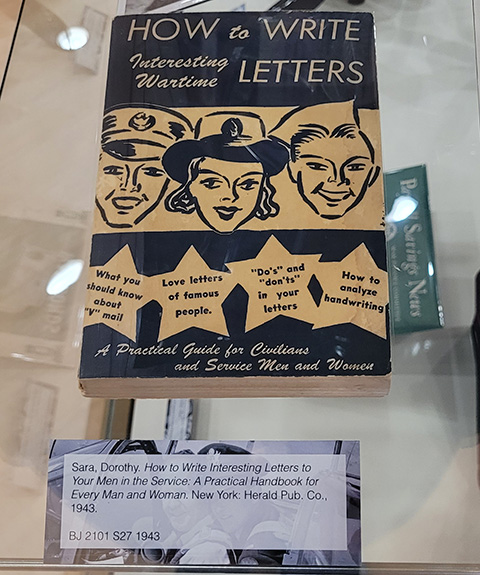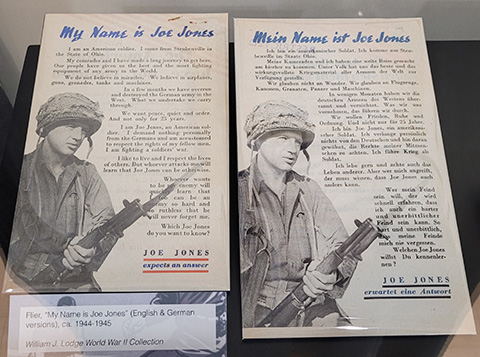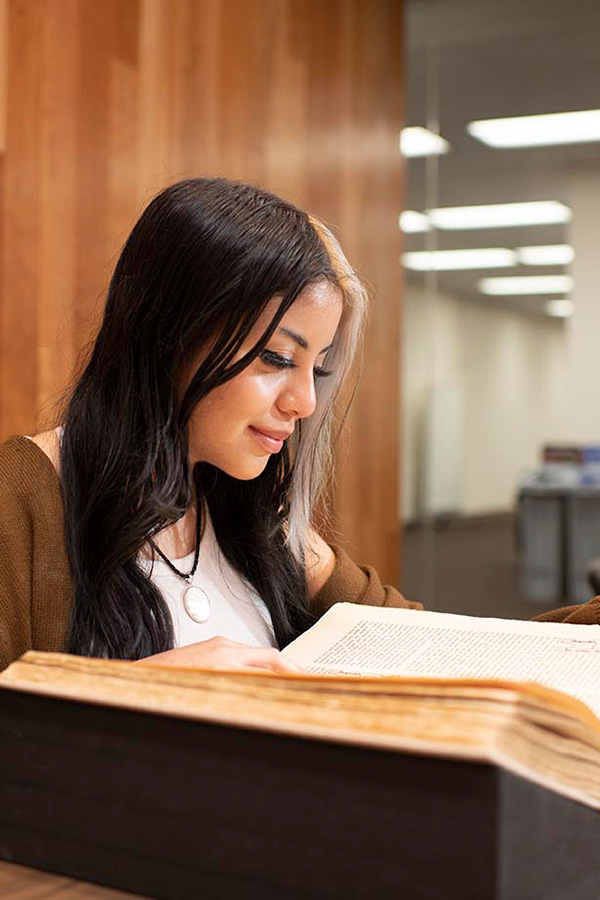Newsletter Edition: Fall 2025
Contributed by Ellen Jarosz (Head, Special Collections & Archives), Mallory Furnier (Special Collections & Archives Librarian), and Gayle O’Hara (University Archivist)

The latest exhibit from Special Collections & Archives, Words of War: Personal Experiences of Conflict, draws the visitor into perspectives of the willing and unwilling participants in conflict through personal correspondence, official forms, newsletters, propaganda, notices, log books and other ephemera. The displays are organized under 12 words or phrases we associate with war and the military, from “Civilians” to “Veterans,” and each case offers a lot to reflect on. We wanted to learn more about how the curators were inspired, so we invited Jarosz, Furnier and O’Hara to tell us more about the experience of building the exhibit. After reading their responses, we encourage you to visit the gallery to form your own impressions.
How did the idea for this exhibition come about?
(Curators) Special Collections & Archives creates a new exhibit each academic year. The themes of the exhibits are planned out several years in advance, and are chosen to showcase some of the strengths of our existing rare book and archival collections and demonstrate how primary and archival sources can be used by students to support their research. We have quite a few archival collections related to personal experiences in war and conflict, so we had plenty of publications and archival materials to choose from.
This is a large, wide-ranging exhibition. How did you shape it?
(Curators) Since we only use materials from Special Collections & Archives, our holdings strongly shape the direction of our exhibits. We started out by surveying the geographic and time ranges of our existing collections related to themes of war and conflict. Although we have items that are centuries-old, our archival collections primarily focus on the 19th and 20th centuries, and so the exhibit looks most closely at this period of time.
When it comes to the specific topics highlighted within that broader theme – Veterans, Military Life, Home Front, Refugees, Genocide, etc. – that was something we decided on after reviewing the archival materials we have in our collections. We had a few other conflicts and topics we would’ve liked to explore more, but we didn’t always have enough materials to fully examine them. For example, we have a lot of materials documenting World War II, but we have fewer materials from more recent conflicts in Vietnam and the Middle East.
How did putting this exhibition together affect you personally? Did you form any specific impressions of how wars have affected people in the San Fernando Valley?
(Furnier) I couldn’t look at an old photograph of children or young soldiers, without thinking of what is happening in our 2025 world. Vicarious trauma is trauma that you experience from viewing or reading distressing materials. Often in archives we come in unexpected contact with traumatic materials. Working on this exhibit while seeing atrocities occurring in real time was a constant reminder of the need to be mindful and aware of ways that trauma can impact us, even when we are not geographically or temporally in an active war zone. Thinking about people in both the past and present made it really important for me to center specific stories of individuals in the exhibit as much as possible, in order to focus on war as a human choice with a human impact.
The exhibit contains quite a few materials from local community groups, women’s civic groups, and labor organizations that document the home front and philanthropic activities in the San Fernando Valley and surrounding areas. You really see how greater Los Angeles became a place of refuge for many people forced out of their homes due to war and conflict in other parts of the world. Though at the same time, the exhibit demonstrates the precarious nature of safety, with materials related to the incarceration of our Japanese American community during World War II, and ongoing conflicts between police and local civilians.
(O’Hara) As Mallory says, it’s hard to see these firsthand accounts and recognize how destructive war and conflict are on individuals, societies, and animals, and yet see this same destruction happening in our current world. It can feel like we are not learning, or in some cases, are purposefully trying to recreate the violence and injustice of past conflicts in new arenas. At the same time, these archival collections are filled with evidence of love, care, and support that people offered to each other, whether soldier or civilian. The work of people in the San Fernando Valley organizing war bond drives, writing letters to soldiers, creating Victory Gardens, and raising money to help those in need is both heartening and inspiring. Emphasizing these stories on an individual and community level is key to wrestling with the past and deciding who we want to be in the present.

(Jarosz) The only thing I can add to these two thoughtful responses is that I was often struck by the relative youth of those whose stories are captured in the photos, letters, and other documents included in the exhibit. I was repeatedly moved by the hopeful, resilient, and personal ways so many of them responded to the challenges they encountered while navigating complex events in real time.
What are the most significant collections the exhibition draws on? What would you like people to know about the collections and their donors?
(Curators) Many of the materials in the gallery came from the James Sefton World War II Correspondence Collection. Dr. James Sefton joined the CSUN History Department faculty in 1965, when campus was still known as San Fernando Valley State College. He taught here for over 50 years. Not long after he passed away in 2018, his expansive collection of World War II era correspondence and related ephemera came to Special Collections & Archives, along with a photograph collection documenting campus life.
Another well represented collection is the Fred M. Greguras Papers. Fred M. Greguras served as a United States Marine in Vietnam in 1970 with Hotel Company, 2nd Battalion, 5th Marine Regiment, before entering the field of law and becoming a partner at a law firm in California. The Fred M. Greguras Papers reflect his research and writing interest in U.S. Marine history through manuscripts, research materials, photographs, and collected ephemera that focus on China Marines and the presence of the U.S. military in Asia. He also more recently donated a collection of materials documenting the changing landscape of military places in California.
There are also a number of materials from the Jewish Federation Council of Greater Los Angeles, Community Relations Committee Collections, especially Part 2 the Los Angeles County Federation of Labor Collection, and the Zaruhy Sara Chitjian Collection.
What do you want visitors to take away from this exhibit?
(Curators) We hope that people realize that war and conflict most impacts everyday people and communities, not the power holders and big decision makers. We are the ones disproportionately on the front lines, the ones who face the most violence, who lose our homes and loved ones, our communities and sometimes our countries. In addition, we hope that people recognize the impact on animals and the environment – this is something often lost in the fog of war. Archives provide evidence of all of this and enable us to reflect and possibly make different decisions in the future. Archives provide stories depicting the best of us, the worst of us, and how we often fall somewhere in between. Archives also hold the powerful to account and that is evident throughout our exhibit. A nuanced examination of the past helps inform the citizenry and motivates civic participation.

